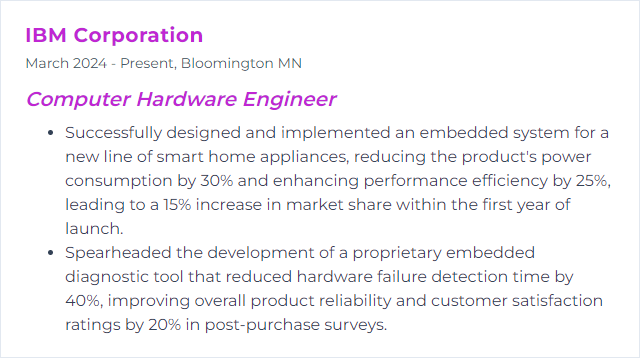Top 12 Computer Hardware Engineer Skills to Put on Your Resume
In the competitive field of computer hardware engineering, having a standout resume is crucial for securing your dream job. Highlighting a balanced mix of technical prowess, inventive problem-solving, and people skills shows you can ship reliable hardware in a world that never slows down.
Computer Hardware Engineer Skills
- VHDL
- Verilog
- Arm Architecture
- FPGA Design
- PCB Layout
- Signal Integrity
- Thermal Analysis
- Power Management
- CAD Tools
- C/C++
- System-on-Chip
- Embedded Systems
1. VHDL
VHDL (VHSIC Hardware Description Language) describes, simulates, and synthesizes digital hardware. From clean RTL to accurate testbenches, it’s the blueprint and the microscope for robust digital systems.
Why It's Important
VHDL enables precise modeling and verification of complex logic, reduces ambiguity, and drives synthesizable designs that map predictably onto FPGAs and ASICs.
How to Improve VHDL Skills
Lock in the language: Get fluent with VHDL-2008 and VHDL-2019 features (packages, fixed/float, protected types, cleaner generics).
Write for synthesis: Prefer synchronous processes, well-defined resets, and avoid latches. Know what maps well to actual hardware.
Testbench muscle: Use transaction-level TBs, self-checking frameworks, and constrained-random stimulus. OSVVM is your friend.
CDC done right: Synchronizers, gray counters, handshakes. No metastability roulette.
Simulate deeply: Exercise corner cases, long runs, and parameter sweeps. Mix behavioral and gate-level sims when timing matters.
Tooling breadth: Be comfortable in multiple simulators (Questa/ModelSim, Vivado Simulator, GHDL) and synth tools.
Refactor ruthlessly: Parameterize. Package reusable code. Keep interfaces tidy and types meaningful.
Improvement sticks when you ship designs, read others’ RTL, and iterate after real failures.
How to Display VHDL Skills on Your Resume

2. Verilog
Verilog models and simulates digital logic. It’s the gateway to ASICs and FPGAs, and often a stepping stone toward SystemVerilog-based verification.
Why It's Important
It captures intent in a form tools understand, enabling early verification, rapid iteration, and fewer surprises in silicon.
How to Improve Verilog Skills
Master the core: Blocking vs non-blocking, always_comb/ff/latch patterns, race-free RTL.
Shift to SystemVerilog: Interfaces, assertions (SVA), and classes for UVM testbenches elevate your verification game.
Verification rigor: Code/functional coverage, constrained random, scoreboards, and checkers.
Timing awareness: Understand delta cycles and event scheduling to avoid simulation mismatches.
Lint and CDC tools: Catch issues early with lint, CDC, and reset-domain checks.
Real projects: Protocol blocks (AXI, I2C, SPI), DSP pipelines, and memory controllers harden your intuition.
Consistent style and disciplined verification separate solid RTL from fragile one-offs.
How to Display Verilog Skills on Your Resume

3. Arm Architecture
Arm is a family of RISC architectures tuned for performance per watt, from tiny microcontrollers to datacenter CPUs. Modern Armv9-A adds deeper security and vector chops without guzzling power.
Why It's Important
Energy efficiency rules mobile and embedded, and it increasingly powers servers. Understanding Arm unlocks a massive chunk of the compute world.
How to Improve Arm Architecture Skills
Know the ISA: Armv8-A to Armv9-A, AArch64, SVE/SVE2, NEON. When to vectorize, when to scalar.
Security features: TrustZone, Pointer Authentication (PAC), Memory Tagging Extension (MTE). Bake security into the design, not after.
Microarchitecture sense: Caches, prefetchers, branch predictors, big.LITTLE/DSU clusters, and coherency fabrics.
Performance engineering: IPC tuning, cache locality, prefetch hints, PMU profiling.
Toolchains and debug: Cross-compilers, linkers, and low-level debug via JTAG/SWD, ETM/ETB trace.
Memory and coherency: Barriers, memory model, shareability domains, CHI/ACE/AXI4 conventions.
How to Display Arm Architecture Skills on Your Resume
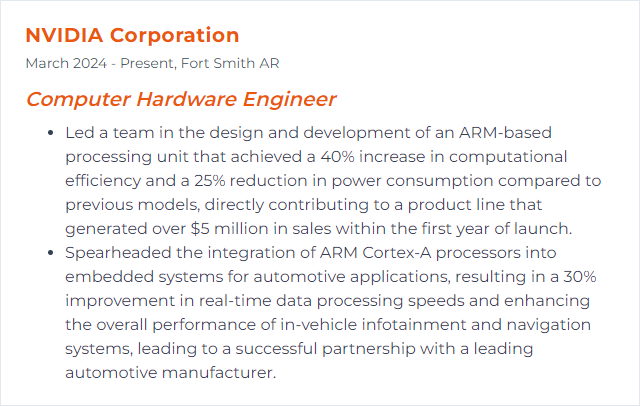
4. FPGA Design
FPGA design turns RTL into living logic. You stitch together DSPs, BRAMs, LUTs, and SERDES to build custom hardware at the speed of iteration.
Why It's Important
Rapid prototyping, hardware acceleration, and deployable products without a mask set. Flexible, fierce, and fast to pivot.
How to Improve FPGA Design Skills
Know the fabric: AMD (Xilinx) versus Intel architectures, resource trade-offs, clocking networks, and I/O banks.
Timing closure: Constraints, generated clocks, false paths. Floorplan hot paths. Pipeline early and often.
CDC and resets: Reliable synchronizers and reset strategies across domains.
Power mindset: Clock gating, resource sharing, and activity reduction to cool the die.
Verification deep dive: Formal on critical blocks, robust TBs, hardware-in-the-loop. Don’t trust a single waveform.
HLS judiciously: Use High-Level Synthesis where it pays, but audit timing and resource reports like a hawk.
How to Display FPGA Design Skills on Your Resume

5. PCB Layout
PCB layout translates schematics into copper, dielectric, and holes. It decides signal quality, emissions, thermals, and whether your product survives the field.
Why It's Important
Poor layout wrecks good circuits. Great layout rescues marginal ones. It’s performance, reliability, manufacturability—in layers.
How to Improve PCB Layout Skills
Stack-up first: Define controlled impedances, reference planes, and dielectric. Plan return paths before you route a single trace.
Placement is destiny: Short high-speed paths, quiet analog islands, power parts with airflow and copper to shed heat.
Rules and constraints: Differential pairs, length matching, clearance, via styles, and impedance rules enforced by the tool.
Grounding that works: Solid planes, stitching vias, split planes only with intent and clear return strategies.
High-speed care: Via stubs (backdrill or blind/buried), reference plane continuity, minimizing layer transitions, and tight coupling.
EMC early: Keep loops small, filter at boundaries, tame edges, and control common-mode currents.
DFM/DFT: Land patterns per IPC, via-in-pad when needed (with fill), testpoints, clear assembly constraints.
Review and simulate: SI/PI checks, thermal review, rule-driven verification. Iterate on prototypes and fix the root causes.
How to Display PCB Layout Skills on Your Resume

6. Signal Integrity
Signal Integrity means your bits arrive intact. No ghosts from reflections, no mush from crosstalk, no jitter soup from shaky references.
Why It's Important
Bandwidth climbs, edges get steeper, margins shrink. Good SI keeps links open, eye diagrams wide, and retries rare.
How to Improve Signal Integrity Skills
Impedance discipline: Controlled traces, consistent references, and proper terminations (series, parallel, Thevenin, AC as required).
Short, straight, deliberate: Compact routes, gentle bends, matched lengths, and minimal via count.
Return paths: Solid planes, stitching around layer jumps, and no plane slots under fast routes.
Crosstalk control: Spacing, orthogonal routing between layers, and guard traces only where justified.
Models matter: Use IBIS/IBIS-AMI and S-parameters to simulate honest channel behavior.
Equalization and pre-emphasis: Tune TX/RX settings, de-embed fixtures, and validate with real eye masks.
Measure, then trust: TDRs, VNAs, scopes with proper probes. Correlate lab data with simulations and fix deltas.
How to Display Signal Integrity Skills on Your Resume

7. Thermal Analysis
Thermal analysis hunts hot spots and tames them. It blends simulation, measurement, and clever mechanical design to keep silicon in its happy zone.
Why It's Important
Overheating throttles performance and kills lifetime. Good thermal design buys reliability, acoustic comfort, and headroom.
How to Improve Thermal Analysis Skills
Simulate airflow and heat: Use CFD and compact models to predict temperatures early; validate once hardware lands.
Pick the right materials: Heat sinks with honest surface area, vapor chambers or heat pipes when density spikes, graphite sheets for tight spaces.
Interface matters: TIM selection and mounting pressure dominate performance. Control flatness and clamping.
Air moves smartly: Shrouds, baffles, and ducting make fans effective. Set sensible fan curves to balance noise and cooling.
Metrics and margins: Track θJA, θJC, and ΨJT. Derate for altitude and ambient swings. Avoid thermal coupling traps.
Measure truth: Thermocouples, IR cameras, on-die sensors. Calibrate. Correlate. Iterate.
How to Display Thermal Analysis Skills on Your Resume
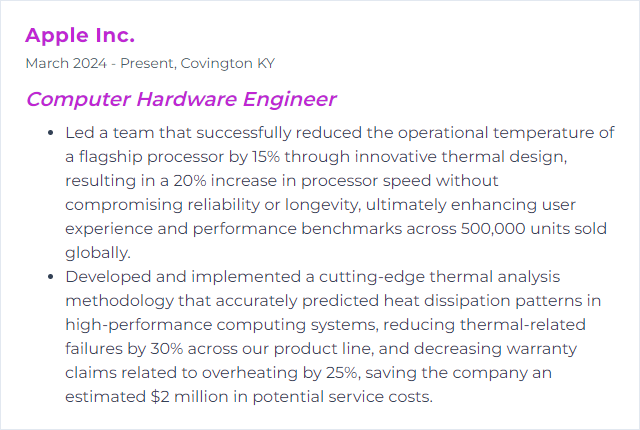
8. Power Management
Power management blends silicon features, board design, and firmware strategy to squeeze performance per joule while keeping thermals sane.
Why It's Important
Lower power means longer battery life, cooler enclosures, higher reliability, and often better acoustics. Efficiency pays dividends everywhere.
How to Improve Power Management Skills
Architect the PDN: Target impedance planning, decap placement by bandwidth, and clean return paths.
Choose efficient regulators: Buck topologies with the right switching frequency, PFM/PWM modes, soft-start, and sequencing logic.
Use DVFS and sleep states: Leverage C/P-states, deep idle, clock gating, power islands, and race-to-idle tactics.
Firmware synergy: Drivers that respect low-power modes, timers coalesced, interrupts batched, and DMA over busy loops.
Measure ruthlessly: Current profiling at rails, PMBus/SMBus telemetry, and workload-based power envelopes.
Thermal ties in: Smarter fan control and thermal throttling schemes reduce wasted power and noise.
How to Display Power Management Skills on Your Resume

9. CAD Tools
CAD tools for hardware mean EDA suites for schematics, PCB layout, simulation, and manufacturing outputs. Speed with these tools turns ideas into boards without drama.
Why It's Important
Strong tool fluency shortens design cycles, reduces errors, and keeps revisions from spiraling.
How to Improve CAD Tools Skills
Library hygiene: Parametric symbols, verified footprints, and 3D models aligned to IPC. One source of truth.
Constraints up front: Impedance, length matching, clearances, and net classes defined before routing starts.
Simulation in the loop: SPICE for analog, SI/PI for high speed. Close the gap between schematic intent and copper reality.
DFM/DFX outputs: Gerber/ODB++, fab and assembly drawings, stack-up notes, pick-and-place, and a clean BOM.
Automation and scripts: TCL/Python macros, design templates, and checklists reduce human error.
Collaboration and versioning: Branch-based reviews, design annotations, and controlled releases keep teams aligned.
How to Display CAD Tools Skills on Your Resume
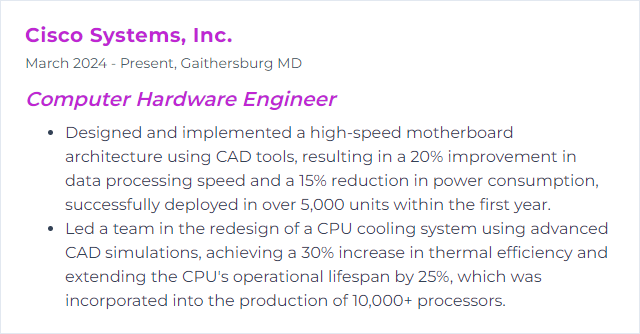
10. C/C++
C/C++ build firmware, drivers, and low-latency systems that talk right to the metal. You get control, speed, and the power to shape hardware behavior.
Why It's Important
Direct access to memory, registers, and timing-critical paths lets you optimize where it counts and validate hardware under real conditions.
How to Improve C/C++ Skills
Core mastery: Pointers, memory ownership, RAII, volatile semantics, and the C/C++ memory model.
Modern features: C++20/23 (constexpr, ranges, concepts), and practical subsets of C23 where relevant.
Toolchain power: Cross-compilation, linkers and map files, LTO, PGO, and fast iterative builds with CMake or equivalents.
Debugging and profiling: JTAG/SWD, trace, perf counters, flame graphs. Use sanitizers (ASan/UBSan/TSan) and static analysis.
Concurrency done safely: Atomics, lock-free structures when needed, and careful latency budgeting in ISRs.
Test and CI: Unit tests, hardware-in-the-loop, fuzzing for parsers and protocol stacks, and continuous integration on target boards.
How to Display C/C++ Skills on Your Resume
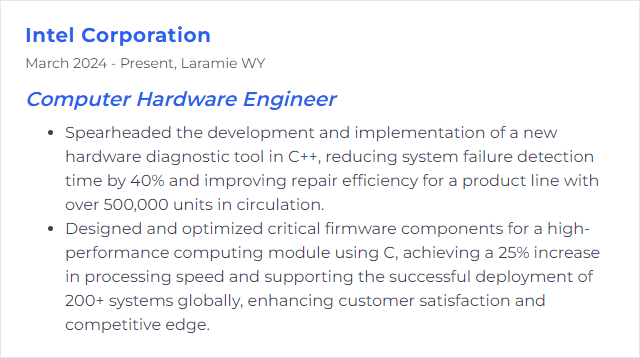
11. System-on-Chip
A System-on-Chip packs CPUs, accelerators, memory interfaces, interconnects, and I/O into one die (or tightly integrated tiles). Performance without a motherboard sprawl.
Why It's Important
SoCs deliver efficiency, cost reductions, and compact designs. They power phones, cars, edge boxes, and servers alike.
How to Improve System-on-Chip Skills
Interconnect savvy: AMBA AXI4/ACE/CHI, NoCs, QoS and arbitration. Latency versus bandwidth trade-offs.
Coherency and caches: MESI-like protocols, snoop filters, LLC sizing, and prefetch strategies tuned to workloads.
Power intent: UPF/CPF, power islands, retention, and power gating with clean bring-up sequences.
Security on die: TrustZone/TEE, secure boot, RoT, and isolation between tenants and peripherals.
DFT and validation: Scan, BIST, trace, emulation, FPGA prototyping, and post-silicon bring-up plans.
Thermals and packaging: Chiplets, interposers, thermal hotspots, and package-aware floorplanning.
How to Display System-on-Chip Skills on Your Resume

12. Embedded Systems
Embedded systems fuse dedicated hardware with software tailored to a precise job, often under real-time constraints. Small devices, tight loops, big responsibility.
Why It's Important
They run everything from wearables to industrial controllers. Reliability and efficiency aren’t optional; they’re the contract.
How to Improve Embedded Systems Skills
RTOS discipline: Tasks, priorities, mutexes, queues, and ISRs tuned for bounded latency. Measure, don’t guess.
Drivers and HALs: Clean abstractions for peripherals (DMA, timers, GPIO, I2C/SPI/USART, USB, PCIe). Device trees where applicable.
Memory and storage: Flash wear leveling, ECC, caches, MPU/MMU protections, and safe bootloaders.
Security from the first commit: Secure boot, signed updates, key management, and least-privilege layouts.
Observability: Logging with rate limits, tracing, metrics, and watchdogs that actually recover the system.
Field readiness: OTA updates, failsafe images, feature flags, and diagnostics to shorten time-to-fix.
How to Display Embedded Systems Skills on Your Resume
